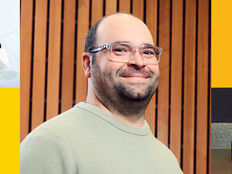Virtual Learning and Digital Classrooms Come Alive
How do you get a roomful of K–12 students to act out on command to test a student teacher's ability to regain control of the classroom? At East Carolina University (ECU) in Greenville, N.C., the answer is to build a three-dimensional simulation in Second Life.
Launched in 2003, Second Life is a 3D virtual world accessed via the Internet. In-world, users are called "residents" and interact with each other through avatars. Organizations such as ECU purchase server space, called "land," and build settings as diverse as the human imagination.
Like similar pioneers, ECU is using virtual worlds to reach students who grew up with online video games and streaming media, making their learning style even more visual than past generations.
"Some people are wary of using 3D tools because they believe they're only for gaming," says Austin Bunch, ECU's senior associate provost. "In truth, they're a much more interactive and integrative form of learning that increases student enthusiasm and improves outcomes."
ECU's education department is a case in point. "In-world, smoke can suddenly billow into a virtual classroom and the instructor has to make quick decisions," says Sharon Collins, director of the Early College Second Life Program in ECU's Emerging Academic Initiatives department.
Sophomore Kathryn Frazier found that experiencing such a simulation in her education class reduced the stress of an otherwise volatile situation. "It was calming to know that if I messed up, nobody would be harmed," she says. "And it built confidence because I received compliments for my actions via text chat along the way."
Virtually Ubiquitous
Beyond educating the next generation of teachers, numerous ECU departments tap into the institution's virtual presence for parts of their on-campus curriculum.
Distance courses, especially, rely on the medium to lend classroom-like experiences where student and faculty avatars interact in real time. "In our distance programs we found that students didn't feel like they were part of the university," Collins acknowledges. "They felt isolated and wanted more connections."
A particularly innovative Second Life initiative is ECU's early college program, which the institution offers to high school students in two adjacent counties. According to Collins, who also serves as the program's director, developing a virtual campus resolved institutional concerns with bringing high school students onto campus.
Seeking to differentiate its program, ECU chose the name Early College Second Life Program. "Most other programs are held at community colleges and require students to leave their home high schools," Collins says. "With ours, students learn in place and receive instruction entirely from regular ECU faculty members."
Starting with 18 students and two courses in a spring 2009 pilot, the program now includes 40 students and 10 courses with further growth anticipated. "Due to the overall budget situation in higher education, we haven't grown the program as quickly as we hope to do in the future," notes Collins.
Indeed, positive outcomes among otherwise average students, as well as high achievers, have area high schools eager to sign on, says Bunch. "In fact, the program is so successful at inspiring average students to continue on to college that the high schools have requested we incorporate a STEM [science, technology, engineering and mathematics] initiative, which we're developing," he says.
Accessing the On-Ramp
Early College students access ECU's in-world campus with notebook computers, which the university supplies for the duration of their enrollment. Students also receive a Logitech headset along with a mouse, a notebook case and a USB thumb drive for storing original and course-related materials.
Similarly, ECU's standard enrolled students access the virtual campus with tools appropriate for their needs. Distance students receive a list of minimum computing requirements. For onsite classes, students and faculty typically meet in one of the university's computer labs. This permits faculty members to make use of the lab's equipment: HP printers; NEC, Sony, Sharp or Toshiba overhead projectors; projection screens; and, where available, either a Panasonic large-format display monitor or an HP Compaq L2105tm touch screen.
Although ECU's virtual campus resides on the Second Life servers, the institution houses and administers supporting systems for developing its in-world presence, including Microsoft Windows media servers running on IBM System machines provided by ECU's Information Technology and Computing Services department.
Additionally, ECU's virtual worlds programmer, James Regan – himself an ECU senior who's graduating this summer – maintains Microsoft SQL and Linux machines for Second Life. To create the learning environments, ranging from replications of physical structures to imaginary settings, Regan uses a standard desktop computer with appropriate graphics capabilities. "Also, for storage and business continuity, we use external terabyte hard drives from Seagate and Western Digital," he says.
Regan performs all design, programming, integration testing and production chores for the environment, with occasional development help from other students inspired by their experience as users. At first, ECU purchased tools for scripting objects, then the three-year veteran of the project began teaching himself the Second Life scripting language.
"Now, we can make our own tools and objects, such as clothing, animals or buildings," Regan says.
ECU's virtual world endeavors also further Regan's professional aspirations, which include video game programming. To illustrate, he points to the brainchild of Associate Professor Elizabeth Hodge, who was the first ECU faculty user to infuse competition into the medium.
"For example, for one course, the first student who correctly completes a question gets to pick their Second Life house or car," he says. "This creative mixture of education and competition gives me the opportunity to be more creative too."
Not surprisingly, Hodge concurs with the creativity aspect. "Using virtual worlds invigorates me as an educator," she says. "If you provide me with just about any type of course, I can envision a way to incorporate virtual worlds to improve engagement, which is one of the most important elements.
"Perhaps you want to teach students about marine biology, and the effects of pollution, but you're on a landlocked campus without direct access to lakes or oceans," she continues. "Instead, you can create a virtual aquatic environment and demonstrate how plants and animals change depending on the types of pollutants. Then you're really touching various cognitive levels, as opposed to regurgitating facts and figures."
Hodge also stresses the significance of simulations in distance education – particularly useful for her, as a professor who teaches predominantly online courses. "ECU's virtual worlds programs have placed me back in the classroom, where I can engage students in synchronous discussions," Hodge says. "Otherwise, distance education is all asynchronous. By using virtual worlds, it becomes a richer experience for both myself and my students."
Libraries, Theaters and Beyond
Today, ECU's in-world campus contains virtual representations of actual buildings, such as the library and career services center, as well as environments specific to courses and subjects.
One recently re-created space is the Globe Theatre, the familiar haunt of playwright William Shakespeare, for Angela Raper, a teaching instructor. She's using the 3D simulation to place her students in the Globe, at scale, for classroom learning and student presentations.
"Second Life allows me to utilize tools I don't have in regular classrooms," Raper explains. "After teaching distance and Early College courses, I'm now beginning to integrate Second Life into my face-to-face courses as well."
Like Hodge, Raper says virtual worlds offer significant educational benefits, such as drawing out her more reticent students. "One of my regular classes was otherwise populated with quiet individuals," she says. "For one activity we went in-world and they exploded with participation. Face to face, you can try to drag conversation out of quiet students. But if they're determined not to talk, it's a futile effort."
If there are any downsides to virtual worlds, it's the amount of orientation and education required just to use the environment fluidly, notes Raper. Right now, this means taking class time to teach her students the basics.
16,000
The number of daily individual account creations worldwide on Second Life
SOURCE: Linden Labs
"My Early College students get a great deal of Second Life support before they come into my courses," Raper acknowledges. "So far, with my face-to-face students, none of them have used it prior to starting my course. But they have picked it up very quickly."
Anthropology professor Jami Leibowitz echoes her colleagues' accolades and concerns, saying she looks forward to a time when ECU students already have virtual world skills. "For example, I'm a cultural anthropologist, so archeology isn't my core strength," she says. "If students were able to build archeological sites in-world, they'd learn more about the subject than I'm able to provide."
Regardless, Hodge says the virtual world experience through Second Life can be just plain gratifying.
"Avatars raise their hand and text-chat so you know what they're asking without interrupting your presentation," she says. "And, when I finish a class, my students' avatars clap – that's a really good thing."

Photo: Marty Haas/Veer
Just Like Home
At East Carolina University, an important benefit of a virtual world such as Second Life is that it can ease the transition to on-campus life for incoming students.
"The ECU Early College Second Life Program taught me to be self-motivated and figure things out on my own while I was still in high school," says Kathryn Frazier, a former Early College participant who is now a sophomore on the ECU campus.
"And there was definitely less culture shock," she adds. "The day I walked onto campus for the first time, it felt more like home."
The same goes for distance learners returning to school to earn higher degrees, says Elizabeth Hodge, an associate professor. "For instance, our virtual library looks just like our campus's physical library," she explains. "When distance students come onto campus for their final defense, they tell me it feels like they've been on campus the entire time."








